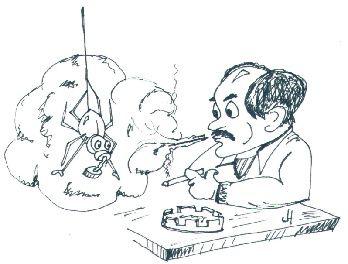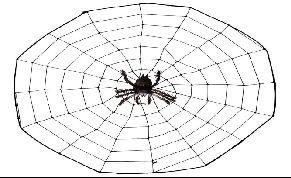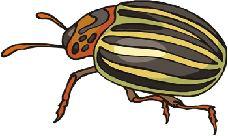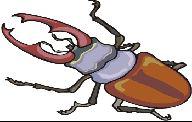Natural Solutions to Things That Bug You (22 page)
Read Natural Solutions to Things That Bug You Online
Authors: Myles Bader

Cobwebs are actually
“draglines”
laid down by spiders wherever they go. This is their lifeline that can be used to drop from one place to another or to help them get out of danger. When they get coated with dust they are called cobwebs.
SOLVING CORNER PROBLEMS
To prevent cobwebs from returning to the corners, just spray the area with a solution of 5% white vinegar with a teaspoon of coconut oil added. The spiders will leave the area alone.
SPIDER SPECIFICS
It is best to purchase an all-natural soap that contains pyrethrum and no other chemical substance to use on spiders. Jungle Rain™ is excellent as well as Dr. Bronner’s Peppermint Soap™.
SALT KILLS
To eliminate spiders just mix 1 ounce of table salt in 1 gallon of warm tap water. This will kill them within a short period of time. Best for use outside and keep away from plants.

SMOKE ‘EM IF YOU GOT ‘EM
Place a whole package of chewing tobacco in 1 gallon of boiling water, remove it from the heat and allow it to cool. Strain the solution into a container, then place 1 cup of the solution and ½ cup of lemon-scented liquid soap into a hose-end sprayer and spray your yard and around the outside of the house. This will eliminate all spiders even the good guys for some time to come. Never use nicotine on roses or they will turn black.
It is poison to humans, animals and fish.
Cigarette smoke will also kill spiders, but we do not recommend taking up smoking to kill them.
KILLER OILS
Only one drop of the following oils in 1 quart of water will kill spiders. Use citronella oil, lavender oil, cinnamon oil, peppermint oil, citrus oil and tea tree oil. It will also kill a number of other insects as well.
When mixing citrus oil in a quart of water add 5 tablespoons of Dr. Bronner’s Peppermint Soap™ to give it some extra kick.

CHAPTER 5


MISCELLANEOUS
GARDEN & PLANT BUGS
MISCELLANEOUS GARDEN & PLANT BUGS
General Information:
There are many natural and chemical remedies to eliminate insect pests. Some remedies work better than others; however, I am providing the ones that tend to work the best. Most of these concoctions can be made with readily available products that will easily be found around the home or purchased from a supermarket or garden supply store. It is always best to only spray the plants that are infested, since many sprays will damage healthy plants that are not infested.
APHIDS
Identification:

 These pear-shaped 1/10
These pear-shaped 1/10
to ½ inch long insects are also called plant lice and are not fussy as to which plants they infest. They can be green, yellow or black. They are usually found on the underneath side of leaves with over 4,000 species identified at present. If you see an aphid that looks swollen and somewhat metallic or is a dull brown or black, it is called a “mummy” and has been invaded by a parasitic wasp. It is best to leave it alone so that the larvae can fully develop.
General Information:
You can find aphids on shrubs, potted plants, all garden plants and even trees. They will cause plant stunting, wilting, yellowing and will eventually kill the plant. They prefer the tender tips, buds and stems of most plants. They insert their piercing mouth into the plant stem or leaves, and proceed to suck out the sap from the plant and deposit honeydew, which attracts other insects. Their nutrition is mainly nitrogen and if you use a high nitrogen fertilizer, it will attract them. Aphids usually appear in the fall.

They tend to transmit a number of diseases and are a serious threat in most gardens. If you see ants traveling up and down a plant, they are probably harvesting the honeydew from the aphids. Predators that eat aphids include ladybugs, lacewings, daddy longlegs, and parasitic wasps (Aphidius wasp).
Beneficial insects that will kill aphids can be used in a greenhouse and raised by placing some aphid-infested leaves in a plastic bag, making sure that the aphids are still on the leaves. In a few days the beneficial larvae will emerge and can be harvested with the tip of a small paintbrush while they are crawling about inside the bag. They can then be released inside the greenhouse to eliminate the aphid problem.
If you use a poison pesticide to kill off the aphids, you will also kill off all the beneficial insects that may control them.
OIL THEM UP
Mix 1 tablespoon of canola oil and add 3-4 drops of Ivory soap, then add to 1 quart of water and mix well. Place the contents into a spray bottle and spray the plants from the top down and then from the bottom up making sure the underneath sides of the leaves are saturated.

ICKY STICKY MESSY
Flypaper is very effective in your garden to trap aphids. If you want to make your own, just use a heavy paper stock and spread Tanglefoot™ on it. Tanglefoot™ can be purchased at most garden supply houses.
THEY SMELL NICE AND DIE
Mix together:
¼ Teaspoon of eucalyptus oil
½ Teaspoon of Ivory Liquid Soap™
½ Teaspoon of canola oil
½ Gallons of water
Place all the ingredients into a bucket and mix well. Place the mixture into a spray and spray the affected areas.
